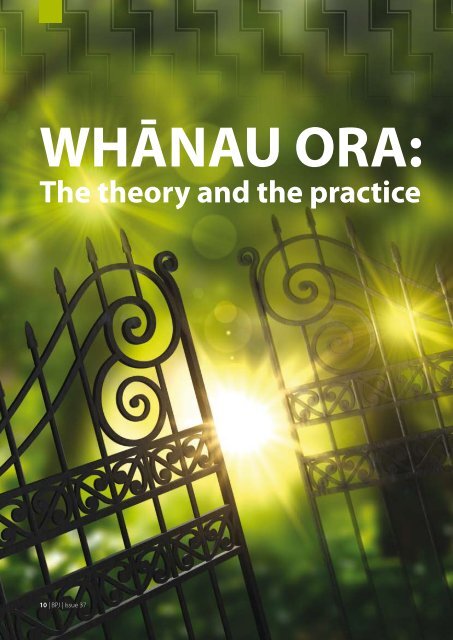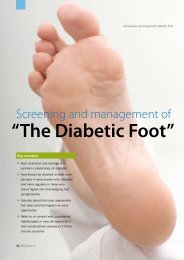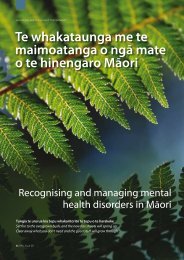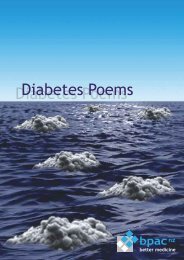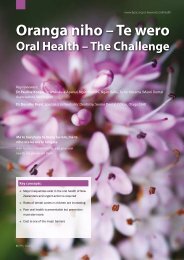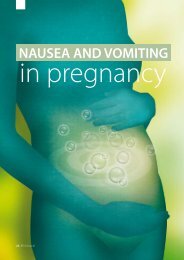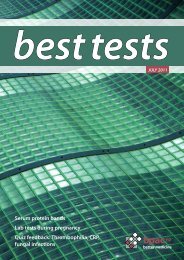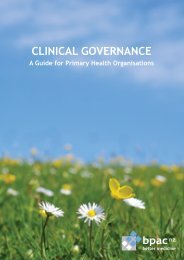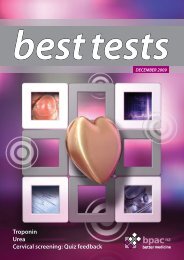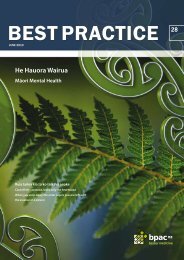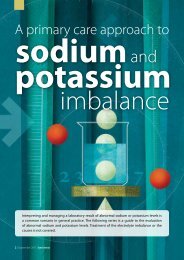The theory and the practice - Bpac.org.nz
The theory and the practice - Bpac.org.nz
The theory and the practice - Bpac.org.nz
- No tags were found...
You also want an ePaper? Increase the reach of your titles
YUMPU automatically turns print PDFs into web optimized ePapers that Google loves.
WHĀNAU ORA:<strong>The</strong> <strong><strong>the</strong>ory</strong> <strong>and</strong> <strong>the</strong> <strong>practice</strong>10 | BPJ | Issue 37
Message from Minister Responsible forWhānau Ora – Hon Tariana TuriaIf <strong>the</strong>re is one thing that we have learnt out of <strong>the</strong>devastation, <strong>the</strong> suffering <strong>and</strong> <strong>the</strong> chaos associated with<strong>the</strong> Christchurch earthquakes, it has been to reacquaintourselves with our neighbours, to come toge<strong>the</strong>r ascommunities, <strong>and</strong> most of all, to reach within our familiesto find <strong>the</strong> greatest source of strength.Whānau Ora is that source – a source of comfort, ofmotivation, of encouragement.Whānau Ora is about whānau being empowered to developa plan for our future; <strong>and</strong> to trust in our own solutions.It is about restoring to ourselves, our confidence in ourown capacity to provide for our own – to take collectiveresponsibility to support those who need it most.I believe that Whānau Ora represents a majortransformation in <strong>the</strong> way services are designed <strong>and</strong>delivered, contracts arranged <strong>and</strong> <strong>the</strong> way providers worktoge<strong>the</strong>r.Whānau Ora taskforceIt has been close to two years (June 2009) since Cabinetapproved <strong>the</strong> establishment of <strong>the</strong> Whānau Ora Taskforce,chaired by Professor Sir Mason Durie.<strong>The</strong> Taskforce held 22 regional hui with a range of urban<strong>and</strong> rural whānau, iwi <strong>and</strong> service providers during October<strong>and</strong> November 2009. Approximately 600 people attended<strong>the</strong>se hui. <strong>The</strong> Taskforce also received more than 100written submissions on its document, “Whānau Ora: Awhānau-centred approach to Māori wellbeing”.Government has appointed a Governance Group to overseeimplementation of Whānau Ora. <strong>The</strong> Governance Group iscomprised of three community representatives <strong>and</strong> threeagency Chief Executives.Over <strong>the</strong> past year, I have watched Whānau Ora gainconsiderable momentum <strong>and</strong> I have been overwhelmedby <strong>the</strong> enthusiasm of stakeholders, whānau, communities,providers, practitioners, government departments <strong>and</strong> myown ministerial colleagues. What could be more inspiringthan witnessing whānau being empowered to take controlof <strong>the</strong>ir future?Selection of Whānau Ora collectivesIn October 2010, Government announced <strong>the</strong> selectionof 25 Whānau Ora provider collectives, which between<strong>the</strong>m bring toge<strong>the</strong>r 158 providers across Aotearoa(including four Pacific providers in Auckl<strong>and</strong>, Wellington<strong>and</strong> Christchurch).It has been wonderful to see <strong>the</strong> high number of providercollectives which in itself expresses Government’s desirefor providers to be more effective <strong>and</strong> efficient by workingcollaboratively.BPJ | Issue 37 | 11
I have heard it described as moving from “five cars up<strong>the</strong> driveway” to one car containing a navigator <strong>and</strong> fourpassengers. <strong>The</strong> shift in mindset is a shift from multipleagencies working with individual family members often inisolation of each o<strong>the</strong>r, to instead a bold <strong>and</strong> innovativeapproach which places <strong>the</strong> aspirations of whānau at <strong>the</strong>centre of service planning <strong>and</strong> delivery. Everyone is facing<strong>the</strong> same direction; <strong>the</strong> focus firmly fixed on outcomes.For whānau – <strong>the</strong> outcomes we seek are that whānau willbe:▪▪ Self-managing▪▪ Living healthy lifestyles▪▪ Participating fully in society▪▪ Confidently participating in Te Ao Māori▪▪ Economically secure <strong>and</strong> successfully involved inwealth creation▪▪ Cohesive, resilient <strong>and</strong> nurturingProgrammes of actionProvider collectives must <strong>the</strong>refore align all of <strong>the</strong>irinteractions to best support whānau wellbeing.Programmes of Action outline a planned approach byprovider collectives to respond to whānau aspirations,<strong>and</strong>, where necessary, to provide whānau-centredservices.Officials from Te Puni Kōkiri, Ministry of Health <strong>and</strong> Ministryof Social Development are working with <strong>the</strong> Whānau Oraprovider collectives to progress <strong>the</strong>ir Programmes of Action.<strong>The</strong>se Programmes serve to inform <strong>the</strong> “business cases”that identify <strong>the</strong> resources required by provider collectives.<strong>The</strong>y include a focus on relationship management,infrastructure, integrated contracting, workforce <strong>and</strong><strong>practice</strong> development, monitoring <strong>and</strong> evaluation <strong>and</strong>action research.Regional leadership groupsAlongside <strong>the</strong>se collectives, <strong>the</strong>re are ten RegionalLeadership Groups which are championing Whānau Orawithin <strong>the</strong>ir respective regions. Each Regional LeadershipGroup comprises community representatives <strong>and</strong> officialsfrom <strong>the</strong> three lead agencies. <strong>The</strong>ir existence serves toremind us that local solutions are determined at <strong>the</strong> locallevel through collaboration <strong>and</strong> cooperation of whānau,hapū <strong>and</strong> iwi.Integrated contractingCentral to <strong>the</strong> development of more holistic service deliveryto whānau is <strong>the</strong> concept of integrated contracting. <strong>The</strong>Ministry of Social Development is currently leading workwith 22 providers <strong>and</strong> <strong>the</strong>ir funders with <strong>the</strong> aim of having20 signed integrated contract agreements this year.Essentially, we envisage <strong>the</strong> transitioning of existingservice delivery contracts into an integrated contractwithin <strong>the</strong> Whānau Ora framework. <strong>The</strong>se outcomes-basedintegrated contracts will bring funding currently receivedfrom government funders toge<strong>the</strong>r into a single contract.Action researchI have always believed that Whānau Ora needed aframework to measure progress toward achievingoutcomes for whānau. <strong>The</strong> last thing I would want is forbean-counting, silo by silo: how many meetings had; howmany people served; how many booklets distributed. SoWhānau Ora will be underpinned by a comprehensiveresearch, evaluation <strong>and</strong> monitoring programme that willmeasure <strong>the</strong> success of <strong>the</strong> approach for whānau, forproviders, <strong>and</strong> in terms of value gained for governmentinvestment. It is about outcomes that are influenced by<strong>the</strong> needs that whānau identify <strong>and</strong> choose.Developing providersIn Budget 2011, Government invested ano<strong>the</strong>r $30 millionin Whānau Ora. <strong>The</strong> emphasis of this new investment willgo towards developing providers in regions of high need<strong>and</strong> where <strong>the</strong>re are currently no provider collectives.<strong>The</strong>se locations include; Kaipara, Hauraki, South Waikato,Taupō/Tūrangi, Palmerston North, Wairarapa, Levin/KapitiCoast <strong>and</strong> Murihiku.12 | BPJ | Issue 37
But if I was to be asked, I would say Whānau Ora is notabout <strong>the</strong> funding. It is about all of us picking up on ourresponsibilities, ra<strong>the</strong>r than picking up <strong>the</strong> phone toask <strong>the</strong> health provider or CYF to take up a role which isrightfully ours.Whānau Ora is possibly <strong>the</strong> first time in which Governmenthas been able to measure value for money against acultural construct.It is about our transformation; celebrating <strong>the</strong> power <strong>and</strong>potential of a whānau-centred approach which will enableour people to flourish.Waipareira has also opened a one-stop frontline WhānauOra hub integrating health, social, justice <strong>and</strong> educationservices. <strong>The</strong> Whānau House – a four-storey complex in<strong>the</strong> central business district of Henderson – is <strong>the</strong> home of<strong>the</strong> trust’s new-look workforce: kaimahi (service workers),kaiārahi (navigators) <strong>and</strong> kaiwhakahaere (leaders).NUMA is <strong>the</strong> parent body for <strong>the</strong> Whānau Ora providercollective that includes; Waipareira, Manukau UrbanMāori Authority (South Auckl<strong>and</strong>), Te Rūnanga o Kirikiriroa(Hamilton) with approved affiliate Te Kohao Health <strong>and</strong>Te Roopu Awhina ki Porirua (Wellington) which is indevelopment.Whānau Ora is <strong>the</strong> ultimate expression of our survival.Tēnā tātou katoa.How is Whānau Ora being delivered?Te Whānau o Waipareira - Auckl<strong>and</strong>Te Whānau o Waipareira in west Auckl<strong>and</strong> – part of <strong>the</strong>National Urban Māori Authority (NUMA) – has beenoperating a “Whānau Ora, Whānau Tahi” approach toservice delivery since January 2011.<strong>The</strong> collective has an enrolled health population of95,000 <strong>and</strong> provides whānau residing in <strong>the</strong> five mainurban centres with nearly 300 individual services acrosseducation, health, housing, justice <strong>and</strong> social services.Services include public health; mental health; primarycare; drug <strong>and</strong> alcohol addiction; Streng<strong>the</strong>ning Families;Family Start; Parents as First Teachers (PAFT); breastscreening; nutrition; smoking cessation; 24/7 accident<strong>and</strong> medical; ACC support; whānau housing; mentoring;holiday programmes; kaumātua support; child advocacy;restorative justice; violence prevention; funeral; housinginitiatives; diabetes; Māori men’s health; budget advice;financial literacy; youth services; youth justice; socialwork support; day activities <strong>and</strong> life skills programmes foradolescents; <strong>and</strong> tikanga Māori.As a specialist Whānau Ora provider, Waipareira is offeringfamilies wrap-around services tailored to <strong>the</strong>ir needs. Akaiārahi, or navigator, will work with whānau to identify<strong>the</strong> aspirations <strong>and</strong> outcomes <strong>the</strong>y seek, develop anoutcomes focused plan to achieve <strong>the</strong>m <strong>and</strong> <strong>the</strong>n broker<strong>the</strong>ir access to a range of services available both internally<strong>and</strong> externally in <strong>the</strong> wider community.More than 200 staff have taken part in training <strong>and</strong>developmental workshops focused on underst<strong>and</strong>ingoutcomes, whānau-centred <strong>practice</strong> <strong>and</strong> underst<strong>and</strong>ing<strong>the</strong> requirements of privacy <strong>and</strong> confidentiality whenworking with whānau.For more information about NUMA, visit:www.numa.<strong>org</strong>.<strong>nz</strong>.Kōtahitanga – Whānau Ora inspired innovationKōtahitanga is a Whānau Ora collective of four Māorihealth <strong>and</strong> social service providers in South Auckl<strong>and</strong>:Turuki Health Care Trust, Papakura Marae Trust, HuakinaDevelopment Trust <strong>and</strong> Te Kaha o Te Rangatahi Trust.<strong>The</strong> collective employs more than 285 staff <strong>and</strong> providesservices to over 22,000 multi-ethnic whānau including16,000 Māori.BPJ | Issue 37 | 13
Whānau Ora – A General Practitioners perspectiveDr Glenn Doherty is a General Practitioner <strong>and</strong> clinicaldirector for specialist Whānau Ora provider Te Whānauo Waipareira in west Auckl<strong>and</strong>. Affiliated to <strong>the</strong> EastCoast tribe of Ngāti Porou, Dr Doherty has worked at <strong>the</strong>Wai Health Clinic – now known as <strong>the</strong> Whānau CentreHealth Clinic – for <strong>the</strong> past three years. He has practisedconsistently as <strong>the</strong> only Māori male General Practitioner inwest Auckl<strong>and</strong> for <strong>the</strong> last 11 years <strong>and</strong> has been workingin health management, policy <strong>and</strong> research <strong>and</strong> clinicalmedicine roles for <strong>the</strong> past 28 years. Dr Doherty has aspecial interest in adolescent <strong>and</strong> youth health <strong>and</strong> hasbeen <strong>the</strong> school doctor at Kelston Boys <strong>and</strong> Hendersonhigh schools in recent years. He is also on <strong>the</strong> ClinicalGovernance Board for <strong>the</strong> Waitemata PHO <strong>and</strong> a newlydeveloped National Māori Health Advisory Council. Hetalks to Best Practice Journal about his work at <strong>the</strong> clinic.What is <strong>the</strong> Whānau Centre Health Clinic?“<strong>The</strong> new centre has been exp<strong>and</strong>ed to include morecomprehensive services than before <strong>and</strong> in time, will beoperating under a ‘Whānau Ora, Whānau Tahi’ kaupapa.We have exp<strong>and</strong>ed to include a dental service <strong>and</strong> onsitepharmacist <strong>and</strong> are in <strong>the</strong> process of co-locatingvarious Waitemata District Health Board services. Weare also negotiating with a radiology service <strong>and</strong> will beco-locating WINZ, CYF <strong>and</strong> ACC within <strong>the</strong> centre. Visitingspecialists <strong>and</strong> a birthing unit are also in <strong>the</strong> process ofbeing developed.”What does Whānau Ora mean to communities?“Whānau Ora is about co-ordinating care on behalf ofpatients <strong>and</strong> ensuring care plans <strong>and</strong> Whānau Ora planscomprehensively address client needs. It is a whānaucentricmodel of service integration using a Māori kaupapato improve all outcomes for our registered clients. Primarycare practitioners will, over time, have centres in <strong>the</strong>irneighbourhoods <strong>and</strong> communities like this one that matrixacross sub-regions to provide services that may have beentraditionally provided under <strong>and</strong> by mainstream servicesor providers.”What are ”wrap-around services”?“Apart from primary <strong>and</strong> secondary health care serviceswithin <strong>the</strong> centre, we have a large amount of education,social services, justice <strong>and</strong> mental health services,which are known as wrap-around services. This meansthat whānau that access our services are looked atcomprehensively – not just snapshots of care or contact.Over time, we will develop a referral triaging process,clinical <strong>and</strong> non-clinical, that ranks client priorities basedon needs. Access <strong>and</strong> socio-economic issues will be takeninto account <strong>and</strong> care plans <strong>and</strong> Whānau Ora plans will bedeveloped around those needs. <strong>The</strong>re will be a fosteringof new models of service delivery that will focus aroundusing Whānau Ora <strong>and</strong> Whānau Tahi models to add valueto client outcomes. We will also be concurrently developinghow we measure our performance to achieve improvedoutcomes for clients.”14 | BPJ | Issue 37
How will General Practitioners be involved?“<strong>The</strong> primary care strategy set <strong>the</strong> scene for ‘better,sooner, more convenient services’ so <strong>the</strong>se WhānauOra centres implicitly will be ‘one-stop shops’ withmost services co-locating under one roof. Thisapproach capitalises on critical mass <strong>and</strong> economiesof scale in communities within <strong>the</strong> context of primarycare. Ultimately, <strong>the</strong>re should be Whānau Ora clausesin contracts with General Practitioners to ensure<strong>the</strong>se principles are manifested in clinical pathwaysto <strong>the</strong>se centres. In addition, General PractitionerClinical Networks will be required to work closelywith <strong>the</strong>se centres <strong>and</strong> ensure <strong>the</strong>y are meaningfullyengaged <strong>and</strong> aligned with <strong>the</strong>se centres.”What o<strong>the</strong>r services does <strong>the</strong> Whānau CentreHealth Clinic offer?“In addition to core general <strong>practice</strong> <strong>and</strong> nursingservices, <strong>the</strong> centre offers podiatry, midwifery <strong>and</strong>dietician services. We are about to employ a GeneralPractitioner to run a chronic care clinic <strong>and</strong> we arelooking at working with an endocrinologist to runvirtual <strong>and</strong> on-site clinics for our difficult diabeticclients. We also have a family violence service,Māori mobile nursing services, cardiac rehabilitationservices <strong>and</strong> oral health services integrated with <strong>the</strong>clinic. <strong>The</strong> centre offers a suite of ten services under<strong>the</strong> ‘Services to Improve Access’ contract. Finally, aMāori mirimiri service (traditional massage) is alsobeing developed. Service navigators will also workto align <strong>and</strong> engage clients with appropriate <strong>and</strong>relevant services.”What is your outlook for <strong>the</strong> future?“This is an exciting time for this urban Māori authorityin west Auckl<strong>and</strong>, to provide services within <strong>the</strong>Whānau House <strong>and</strong> for staff working in <strong>the</strong> centre<strong>and</strong> for our community. Waipareira is <strong>the</strong> only serviceentity of its kind in New Zeal<strong>and</strong> run <strong>and</strong> operated byMāori for all people wanting new approaches to <strong>the</strong>irpersonal care <strong>and</strong> <strong>the</strong> care of <strong>the</strong>ir whānau.”Kōtahitanga has developed a new whānau-centredmodel of <strong>practice</strong>, Mana Tiaki, to address <strong>the</strong> unmetneeds of whānau. <strong>The</strong> model is applied across a networkof providers <strong>and</strong> is evidence-based, outcomes-driven<strong>and</strong> strengths-focused. It is based upon <strong>the</strong> premise ofsupporting <strong>and</strong> enabling whānau-centric <strong>practice</strong> <strong>and</strong> canbe applied to any whānau who chooses it, although it isnot exclusive to Māori.Mana Tiaki also enhances provider member capacity todeliver high quality services to whānau as it supportsimproved <strong>and</strong> coordinated access to a range of niche orspecific services that are delivered by <strong>the</strong> network.As with o<strong>the</strong>r Whānau Ora collectives, Kōtahitanga providesa range of health <strong>and</strong> social services across a continuumof care. <strong>The</strong> collective also provides innovation acrossareas such as te reo-based rangatahi services, specialistcultural needs assessment for kuia <strong>and</strong> kaumātua, wahine<strong>and</strong> pepi services that have world class accreditation,marae-based <strong>and</strong> integrated services, intersectoralservice delivery, a mix of rural <strong>and</strong> urban services, iwi <strong>and</strong>mata waka networks <strong>and</strong> cultural competency systems.Alliance Health+ Trust – a Whānau Ora Collectivemeeting <strong>the</strong> needs of Pacific peoplesAlliance Health+ Whānau Ora Collective represents sixproviders including: Auckpac, Bader Drive, HealthstarPacific, Penina Health Trust, Southseas <strong>and</strong> Tongan HealthSociety.For <strong>the</strong> past 20 years, members of this provider collectivehave customised services to meet <strong>the</strong> needs of Pacificpeoples <strong>and</strong> high needs populations in Auckl<strong>and</strong>. In doingso, <strong>the</strong> collective have long-established relationships withPacific churches <strong>and</strong> community interest groups to ensure<strong>the</strong> voices of <strong>the</strong>se groups are representedIn 2010, Alliance Health+ was established in responseto <strong>the</strong> Ministry of Health policy – Better, Sooner, MoreConvenient Health Care in <strong>the</strong> Community – whichresulted in <strong>the</strong> consolidation of three Pacific-led PrimaryBPJ | Issue 37 | 15
Turning to Whānau Ora in times of needRenee Muru is <strong>the</strong> primary health care manager for TurukiHealth Care in South Auckl<strong>and</strong> – part of <strong>the</strong> Kōtahitangaprovider collective.Renee says that meeting people <strong>and</strong> home visits are a keypart of <strong>the</strong>ir Whānau Ora service approach which aimsto put a complete package of support around people’shealth <strong>and</strong> social needs.“In simple terms, health problems are often closely relatedto things like housing, income, education, transport,employment, nutrition <strong>and</strong> smoking cessation,” she says.“It’s important to see <strong>the</strong> whole individual in <strong>the</strong> contextof <strong>the</strong>ir whānau. By collaborating with o<strong>the</strong>r agencies wecan address <strong>the</strong> factors that contribute to ill health, makea positive difference <strong>and</strong> get some great outcomes forwhānau.”As part of <strong>the</strong> Kōtahitanga collective, Turuki worked withmore than 20 individuals who arrived in Auckl<strong>and</strong> after<strong>the</strong> Christchurch earthquake in February.As well as no food or accommodation, <strong>and</strong> no knowledgeof local support systems, <strong>the</strong>ir social <strong>and</strong> health needswere varied. <strong>The</strong>y underwent needs assessments drivenby <strong>the</strong>ir own goals <strong>and</strong> aspirations with access to servicesacross a network of providers.Turuki helped <strong>the</strong> whānau in a number of ways, including;enrolling <strong>the</strong>ir children in schools, assessing immediatehealth needs as many came without vital medication,providing support with counselling services <strong>and</strong> helpingto secure accommodation.“A number of <strong>the</strong>se clients have never been beneficiaries<strong>and</strong> using <strong>the</strong> services of WINZ <strong>and</strong> Housing New Zeal<strong>and</strong>were very foreign to <strong>the</strong>m,” says Renee.“This work is ongoing <strong>and</strong> we are continuing to support anumber of families with <strong>the</strong>ir short term, medium <strong>and</strong> longterm goals.”16 | BPJ | Issue 37
Health Organisations (PHOs): Ta Pasifika (Bader Drive<strong>and</strong> Southseas), Auckpac PHO <strong>and</strong> Tongan Health SocietyPHO.integrated care through <strong>the</strong> delivery of wrap-aroundservices that meet <strong>the</strong> needs of <strong>the</strong> consumer <strong>and</strong> <strong>the</strong>irfamily.Whānau Ora is a concept that strongly aligns with Pacificvalues <strong>and</strong> provides an exciting opportunity to enhanceprimary care. <strong>The</strong> inclusion of o<strong>the</strong>r Pacific non-government<strong>org</strong>anisation (NGO) providers such as Healthstar Pacific<strong>and</strong> Penina Trust helps achieve <strong>the</strong> holistic outcomes forwhānau.Within a year, Integrated Family Health Centres (IFHCs) willbe a central hub in which some of <strong>the</strong> collective’s modelof care activities will occur. <strong>The</strong> centres will offer a rangeof services for whānau to easily access in one locationacross <strong>the</strong> health <strong>and</strong> social sector, <strong>and</strong> externally with keygovernment agencies <strong>and</strong> NGOs.<strong>The</strong> collective has developed O Le Aiga mā le Fanau iaOla Pacific framework for Whānau Ora which describeshealth <strong>and</strong> wellbeing in <strong>the</strong> context of relationships, socialenvironments <strong>and</strong> <strong>the</strong> wider determinants of health.It takes a long-term perspective of building for futuregenerations.Alliance Health+ is focused on greater co-ordinated <strong>and</strong>Looking ahead, Alliance Health+ plans to continue tofocus on key areas: structural change by streng<strong>the</strong>ning<strong>the</strong> Alliance Health+ clinical governance programme;establishment of integrated family health centres <strong>and</strong>nurse-led clinics/networks; development of populationhealth programmes for communities; WhānauOra (enhanced primary care); <strong>and</strong> acute dem<strong>and</strong>management.Department of General Practice <strong>and</strong> Rural HealthDunedin School of Medicine, University of OtagoDivision of Health SciencesComplementary Medicine – its place inprimary care – GENX 826Semester Two – 2011Commences with <strong>the</strong> first residential in Dunedin on August 27 & 28 <strong>and</strong> finishes with a residential onNovember 26 & 27.Study of this paper will equip GPs with <strong>the</strong> knowledge base to help <strong>the</strong>ir patients make informed healthcare choices in relation to complementary <strong>the</strong>rapies.STUDENTS WILL GAIN:• An overview of non-conventional treatmentoptions available in <strong>the</strong> primary healthcaresector <strong>and</strong> of reasons patients give for using<strong>the</strong>m.• Underst<strong>and</strong>ing of <strong>the</strong> different health careperspectives that underlie complementary<strong>practice</strong>s <strong>and</strong> how <strong>the</strong>y fit with generalmedical <strong>practice</strong>.• Knowledge about existing research ofcomplementary <strong>the</strong>rapies, how to accessevidence-based information <strong>and</strong> what <strong>the</strong>specific challenges are for research in thisfield.• Underst<strong>and</strong>ing of <strong>the</strong> legal <strong>and</strong> regulatoryenvironment for complementary <strong>practice</strong>s inNZ.For more information contact:Anita Fogarty, Postgraduate Administrator03 479 7424 or 021 279 7424Email: gp.postgrad@otago.ac.<strong>nz</strong>www.otago.ac.<strong>nz</strong>/dsm/gp


